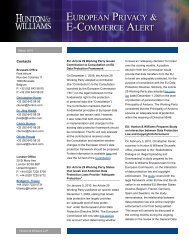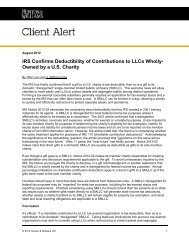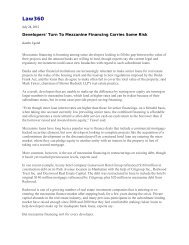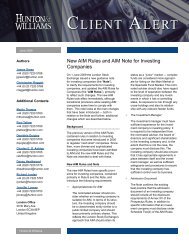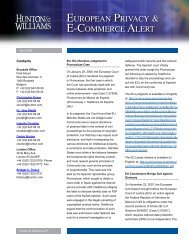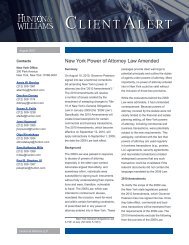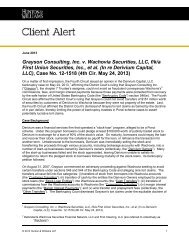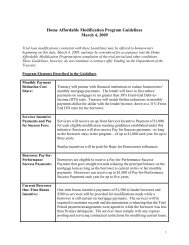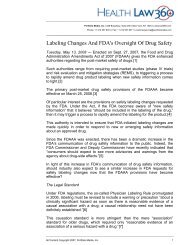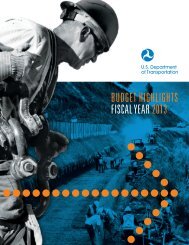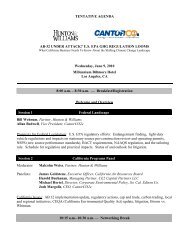Hunton & Williams Renewable Energy Quarterly, September 2009
Hunton & Williams Renewable Energy Quarterly, September 2009
Hunton & Williams Renewable Energy Quarterly, September 2009
Create successful ePaper yourself
Turn your PDF publications into a flip-book with our unique Google optimized e-Paper software.
<strong>Renewable</strong> <strong>Energy</strong> <strong>Quarterly</strong><br />
Recovery Act Guidance Update<br />
Treasury Grant Program<br />
On July 9, <strong>2009</strong>, the U.S. Treasury Department (“Treasury”)<br />
released guidance related to the Treasury Grant program<br />
enacted under Section 1603 of the American Recovery and<br />
Reinvestment Tax Act of <strong>2009</strong>. Generally, Section 1603<br />
provides a 10 percent or a 30 percent cash grant in lieu of<br />
investment tax credits for certain renewable energy facilities<br />
that are (a) placed in service in <strong>2009</strong> or 2010 (regardless of<br />
when construction began) or (b) placed in service after 2010<br />
but before the applicable placed-in-service deadline for such<br />
facility, but only if the construction of such property began<br />
during <strong>2009</strong> or 2010. The Treasury Grant is available only<br />
for property that is used in a trade or business or held for the<br />
production of income. Accordingly, nonbusiness energy property<br />
and residential energy-efficient property eligible for tax<br />
credits under Section 25C and 25D of the Internal Revenue<br />
Code (the “Code”) do not qualify for a Treasury Grant.<br />
This article is only a summary of certain aspects of the<br />
Treasury Grant program guidance. Complete details regarding<br />
the application process and the program guidance are<br />
available at http://www.treasury.gov/recovery/1603.shtml.<br />
Application. In addition to the program guidance, the<br />
Treasury also released an application and other related<br />
documents. Applications must be submitted online at https://<br />
treas1603.nrel.gov/. For property placed in service in <strong>2009</strong> or<br />
2010, an application cannot be submitted for a project until<br />
after the project is placed in service, and must be submitted<br />
before October 1, 2011. For projects that are under construction<br />
in <strong>2009</strong> or 2010, but not placed in service until after<br />
2010, applications must be submitted after construction has<br />
begun, but before October 1, 2011.<br />
Payment of the cash grant will be made within 60 days<br />
from the later of (a) the date of the completed application or<br />
(2) the date the property is placed in service. For projects<br />
that are not placed in service when the application is submitted,<br />
the application process may include two stages (an<br />
initial application and supplemental information).<br />
Certain documentation must be submitted with the application<br />
to demonstrate that the property is eligible property that<br />
has been placed in service or, if placed in service after 2010,<br />
that construction began in <strong>2009</strong> or 2010. The types of documentation<br />
that must be submitted depend on the type of and<br />
other facts relating to the facility.<br />
Eligible Applicants. Certain entities are not eligible for<br />
Treasury Grants, including (a) federal, state or local governments<br />
(or any political subdivision, agency or instrumentality<br />
thereof), (b) any organization described in Section 501(c) of<br />
the Code and exempt from tax under Section 501(a) of the<br />
Code, (c) any entity described in Section 54(j)(4) of the Code<br />
or (d) any partnership or other pass-thru entity that has any<br />
of the entities described in (a) through (c) above as a direct<br />
or indirect partner, unless such ineligible entity owns an indirect<br />
interest in the applicant-partnership through a taxable C<br />
corporation. The guidance clarifies that a foreign person or<br />
entity is eligible for a cash payment if at least 50 percent of<br />
the income of the person or entity (or shareholder) is subject<br />
to U.S. income tax (the exception provided under Section<br />
168(h)(2)(B) of the Code).<br />
Beginning of Construction. When construction begins is<br />
important for projects on which construction begins in <strong>2009</strong><br />
or 2010 but the project is not placed in service until after<br />
2010. It has no impact on projects in which construction<br />
began before <strong>2009</strong>, if those projects are indeed placed in<br />
service in <strong>2009</strong> or 2010.<br />
The guidance provides that construction begins when physical<br />
work of a significant nature begins and provides a safe<br />
harbor rule. In the case of self-constructed property (the<br />
applicant manufactures, constructs or produces property<br />
for its own use in a trade or business or for the production<br />
of income), construction begins when physical work of a<br />
significant nature begins. Physical work does not include<br />
preliminary activities (planning, designing, securing financing,<br />
exploring, researching, clearing site, test drilling, etc.).<br />
The guidance provides, for example, that construction<br />
begins when work begins on the excavation for a foundation,<br />
the setting of anchor bolts into the ground or the pouring of<br />
concrete foundations. If the energy property is assembled<br />
from modular units off-site, construction begins when physical<br />
work of a significant nature commences at the off-site<br />
location.<br />
In the case of property that is manufactured, constructed or<br />
produced for the applicant by another person under a written<br />
binding contract, construction begins when physical work of<br />
a significant nature begins under the contract. A contract is<br />
a binding contract if it is enforceable under state law against<br />
the applicant, does not limit damages to an amount less than<br />
17 <strong>Renewable</strong> <strong>Energy</strong> <strong>Quarterly</strong> www.hunton.com



